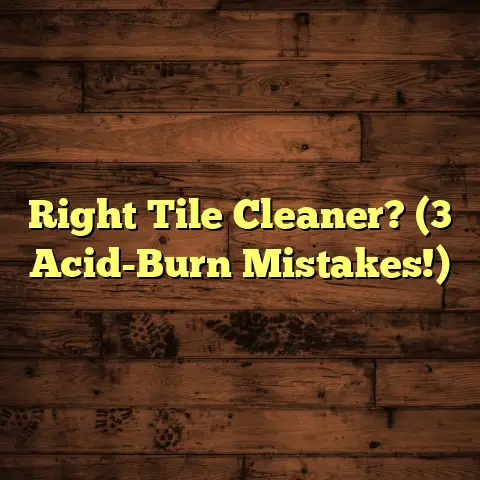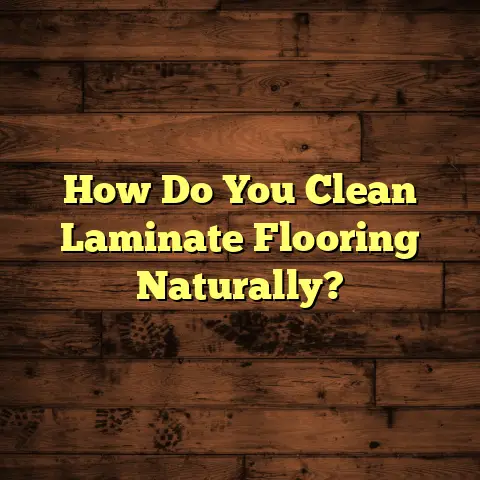Slippery Tile Floors: What To Do? (4 Fixes Now!)
Yeah, slippery tile floors are no joke.
I’ve seen firsthand the hazards they pose, especially for families with young kids, older adults, or anyone with mobility issues.
Trust me, as a flooring contractor for over 15 years, I’ve slipped (pun intended!) into this topic more times than I can count.
Safety in our homes and workplaces is paramount, and when your beautiful tile turns into an ice rink, we’ve got a problem.
Did you know that falls are a leading cause of injury?
According to the CDC, one in five falls causes a serious injury such as broken bones or a head injury.
That’s a scary statistic, and it hits home when you realize a simple slip on your tile floor could contribute to that.
That’s why I’m here to walk you through some practical solutions.
We’re talking real, actionable fixes you can implement now to reclaim your floor and your peace of mind.
Section 1: Understanding the Causes of Slippery Tile Floors
So, why does this happen? Why does that gorgeous tile suddenly become a hazard?
Let’s break it down.
-
The Tile Type:
- Glossy tiles, like polished porcelain or glazed ceramic, look fantastic, but their smooth surface offers less friction.
- Think of it like this: the shinier the tile, the slicker the slide.
- Matte finish tiles, on the other hand, have a slightly rougher texture, providing more grip.
-
Moisture is the Enemy:
- Water, spills, even humidity can turn any tile into a skating rink.
- Ever notice how much more slippery your bathroom floor is right after a shower?
- That’s because water reduces the friction between your feet and the tile surface.
-
The Invisible Build-Up:
- Dirt, oils from cooking, and even residue from cleaning products can create a film on your tile.
- This film acts like a lubricant, making the surface extra slippery.
- I’ve seen floors that look clean but are secretly coated in a thin layer of grime!
Now, let’s get a bit more technical.
Ceramic and porcelain tiles, while durable and beautiful, can be naturally slick due to their manufacturing process.
The smooth, non-porous surface that makes them easy to clean also makes them prone to slipperiness.
Improper maintenance is a HUGE culprit.
Using the wrong cleaning products, or not rinsing thoroughly after cleaning, can leave behind a residue that exacerbates the problem.
I once had a client who was using a floor cleaner that contained wax.
While it made the floor shine, it also made it incredibly slippery!
Section 2: Safety First – The Importance of Addressing Slippery Floors
Okay, we know why floors get slippery.
But let’s really drill down on why it matters.
-
Serious Injuries:
- Falls can lead to fractures, sprains, head injuries, and more.
- For older adults, a fall can have devastating consequences, leading to loss of independence and decreased quality of life.
-
The Ripple Effect:
- Beyond the physical pain, falls can cause emotional distress, fear of falling again, and financial burdens due to medical bills and lost work time.
- It’s not just about the immediate injury; it’s about the long-term impact on your life and well-being.
I’m a big believer in preventative measures. Regularly evaluating your flooring environment is key.
Take a walk around your home or business and ask yourself:
- Are there areas that consistently get wet?
- Are there areas with high foot traffic?
- Are there any changes in flooring condition that could increase the risk of slips?
Proactive measures are crucial, especially in commercial settings where you have a responsibility to provide a safe environment for employees and customers.
Think about it: a simple fix now can prevent a potentially devastating accident later.
Section 3: Fix #1 – Anti-Slip Treatments
Alright, let’s get to the solutions! First up: anti-slip treatments.
These are products designed to increase the traction of your tile floors.
-
How They Work:
- Chemical Treatments: These treatments etch the surface of the tile, creating microscopic textures that increase grip.
- They don’t change the look of the tile dramatically, but they make a HUGE difference in slip resistance.
- Coatings: These are applied like a sealant, creating a textured layer on top of the tile.
- They can sometimes alter the appearance of the tile, so it’s important to choose carefully.
-
Application:
- Most anti-slip treatments are relatively easy to apply.
- You’ll typically clean the floor thoroughly, apply the treatment according to the manufacturer’s instructions, and let it dry.
- Some treatments require multiple coats.
-
Durability & Maintenance:
- The durability of anti-slip treatments varies depending on the product and the amount of foot traffic.
- You’ll likely need to reapply the treatment every few years to maintain its effectiveness.
- Regular cleaning is still essential!
I’ve used several anti-slip treatments over the years, and I’ve been consistently impressed with their effectiveness.
One of my favorites is SlipDoctors Stone Grip.
It’s a chemical treatment that works well on porcelain and ceramic tiles.
It’s also worth looking for products with certifications from organizations like the National Floor Safety Institute (NFSI).
These certifications indicate that the product has been tested and proven to reduce the risk of slips and falls.
Important Note: Always test any anti-slip treatment in an inconspicuous area first to ensure it doesn’t damage or discolor your tile.
Section 4: Fix #2 – Area Rugs and Mats
This one might seem obvious, but it’s incredibly effective and often overlooked!
Strategically placing area rugs and mats can significantly reduce the risk of slips and falls.
-
The Non-Slip Factor: The KEY here is to choose rugs and mats with non-slip backings.
- Look for rugs with rubber or latex backings that will grip the floor and prevent the rug from sliding around.
- You can also purchase separate non-slip rug pads to place underneath your existing rugs.
-
Size and Material Matters:
- Choose rugs that are large enough to cover high-traffic areas.
- Avoid overly thick or plush rugs that could create a tripping hazard.
- Opt for materials that are absorbent and quick-drying, especially in areas prone to spills.
-
Strategic Placement:
- Entryways: Place a mat just inside the door to catch dirt and moisture.
- Kitchen: Use a runner in front of the sink and stove to absorb spills.
- Bathrooms: Place mats in front of the shower, tub, and toilet to prevent slips on wet floors.
I remember a client who had a beautiful but incredibly slippery entryway.
They were constantly worried about guests slipping when they came in from the rain.
We added a large area rug with a non-slip backing, and it completely solved the problem!
Not only did it improve safety, but it also added a touch of style to the entryway.
Don’t underestimate the power of a well-placed rug or mat!
Section 5: Fix #3 – Regular Cleaning and Maintenance
Okay, this might sound boring, but trust me: proper cleaning is crucial for maintaining a safe floor.
The Cleaning Regimen:
- Sweep or vacuum regularly: Remove dirt, dust, and debris that can contribute to slipperiness.
- Use the right cleaning products: Avoid harsh chemicals or abrasive cleaners that can damage the tile or leave behind a slippery residue.
- Mop with a pH-neutral cleaner: These cleaners are gentle on tile and won’t leave behind a film.
- Rinse thoroughly: This is KEY!
Make sure to remove all traces of the cleaning product. - Dry the floor: Use a clean, dry mop or towel to remove any excess water.
-
What to Avoid:
- Oil-based cleaners: These can leave behind a slippery residue.
- Wax-based cleaners: While they make the floor shine, they also make it incredibly slippery.
- Abrasive cleaners: These can scratch the tile and damage the finish.
-
Maintenance Schedule:
- Daily: Sweep or vacuum high-traffic areas.
- Weekly: Mop the entire floor with a pH-neutral cleaner.
- Monthly: Inspect the floor for any signs of damage or wear and tear.
I always tell my clients that cleaning is an investment in the longevity and safety of their floors.
Think of it this way: a clean floor is a happy floor, and a happy floor is a safe floor!
I once spoke with a representative from a major tile manufacturer, and they emphasized the importance of using pH-neutral cleaners to maintain the slip resistance of their tiles.
They said that harsh chemicals can actually strip away the protective finish on the tile, making it more prone to slipperiness.
Section 6: Fix #4 – Choosing the Right Tile
Okay, this is the long-term solution.
If you’re renovating or building a new home, you have the opportunity to choose tiles that are inherently less slippery.
Material Matters:
- Textured Tiles: Look for tiles with a textured surface, such as slate or travertine.
These natural textures provide excellent grip. - Matte Finish Tiles: As we discussed earlier, matte finish tiles are generally less slippery than glossy tiles.
- Slip-Resistant Tiles: Some manufacturers offer tiles specifically designed for slip resistance.
- Textured Tiles: Look for tiles with a textured surface, such as slate or travertine.
Understanding COF Ratings:
- COF stands for Coefficient of Friction.
It’s a measure of how much friction exists between two surfaces. - The higher the COF rating, the less slippery the tile.
- Look for tiles with a COF rating of 0.6 or higher for wet areas.
- COF stands for Coefficient of Friction.
-
Where to Use Safer Tiles:
- Bathrooms: This is the most important area to choose slip-resistant tiles.
- Kitchens: Spills are common in kitchens, so slip-resistant tiles are a good choice.
- Entryways: Choose tiles that can withstand moisture and provide good traction.
- Outdoor Areas: If you have a patio or deck, choose tiles that are designed for outdoor use and have a high COF rating.
I worked on a project where the client specifically requested slip-resistant tiles for their bathroom remodel.
They had young children and were concerned about the risk of slips and falls.
We chose a textured porcelain tile with a high COF rating, and they were thrilled with the results!
Not only did it look great, but it also gave them peace of mind knowing that their bathroom was safer for their family.
Choosing the right tile is an investment in the long-term safety and well-being of your home.
Conclusion
So, there you have it! Four effective fixes for slippery tile floors.
Remember, addressing this issue is crucial for preventing accidents and ensuring a safe living environment for yourself, your family, and your guests.
Don’t wait until someone gets hurt to take action.
Implement one of these fixes today and reclaim your floor!
Whether it’s applying an anti-slip treatment, adding area rugs, improving your cleaning routine, or choosing safer tiles for your next renovation, every step you take will make a difference.
I encourage you to share your experiences and solutions for slippery tile floors in the comments below.
Let’s create a community of awareness and safety!
Call to Action
Want more home improvement tips and tricks?
Subscribe to my newsletter for updates on related topics and stay informed about home safety issues!





